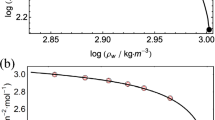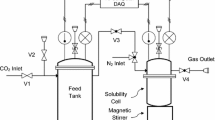Abstract
Using pressure-jump, concentration-jump, and stopped-flow methods, we have studied the rate of dehydration (k−1) of carbonic acid as a function of temperature (0–40°C) and ionic strength (0.005–3M NaCl, 3M LiBr) in both H2O and D2O. A new design of pressure-jump cell with reliable temperature control, as well as improved sensitivity in the spectrophotometric detection for stopped flow, enabled k−1 values to be determined with an accuracy better than ±8%, based on a comparison of results obtained using five different techniques. The influence of ionic strength, temperature, and isotope effects are discussed.
Similar content being viewed by others
References
J. McBain,J. Am. Chem. Soc. 101, 814 (1912).
K. Kern,J. Chem. Educ. 37, 14 (1960).
M. Eigen and L. De Maeyer, inTechnique of Organic Chemistry, A. Weissberger, ed. (Interscience, New York, 1963), 2nd ed., Vol. VIII/2.
S. Ljunggren and O. Lamm,Acta Chem. Scand. 12, 1834 (1958).
H. Strehlow and M. Becker,Ber. Bunsenges Physik. Chem. 63, 457 (1959).
R. C. Patel, R. J. Boe, and G. Atkinson, in preparation.
M. Eigen, G. Kurtze, and K. Tamm,Z. Elektrochem. 56, 103 (1953).
H. Strehlow,Z. Elektrochem. 66, 392 (1962).
R. C. Patel, G. Atkinson, and R. J. Boe,J. Chem. Educ. 47, 800 (1970).
I. M. Kolthoff, inAcid-Base Indicators (The Macmillan Co., New York, 1937), p. 293.
Handbook of Chemistry and Physics, R. C. Weast, ed. (The Chemical Rubber Co., Cleveland, Ohio, 1966), 47th ed.
G. Schwarzenbach,Helv. Chim. Acta 40, 907 (1957).
C. J. Faurholt,Chim. Phys. 21, 400 (1924).
R. Saal,Rec. Trav. Chim. 47, 73 (1928).
R. Brinkman, R. Margaria, and F. Roughton,Phil. Trans. Roy. Soc. A232, 65 (1933).
F. J. W. Roughton,J. Am. Chem. Soc. 63, 2930 (1941).
K. Dalziel,J. Biochem. 55, 79 (1933).
Q. Gibson and F. Roughton,Proc. Roy. Soc. B143, 310 (1955).
P. Scheuer, R. Brownell, and J. LuValle,J. Phys. Chem. 62, 809 (1958).
J. Sirs,Trans. Faraday Soc. 54, 201 (1958).
R. L. Berger and L. C. Stoddart,Rev. Sci. Instr. 36, 78 (1965).
R. C. Patel, G. Atkinson, and R. J. Boe, in preparation.
R. C. Patel and G. Atkinson, 160th Meeting of the American Chemical Society, Chicago, September 13–18, 1970.
K. J. Laidler, inChemical Kinetics (McGraw-Hill Book Co., New York, 1965), 2nd ed.
M. Eigen, K. Kustin, and G. Maas,Z. Physik. Chem. N.F. 30, 130 (1960).
Author information
Authors and Affiliations
Rights and permissions
About this article
Cite this article
Patel, R.C., Boe, R.J. & Atkinson, G. The CO2-water system. I. Study of the slower hydration-dehydration step. J Solution Chem 2, 357–372 (1973). https://doi.org/10.1007/BF00713250
Received:
Revised:
Issue Date:
DOI: https://doi.org/10.1007/BF00713250




